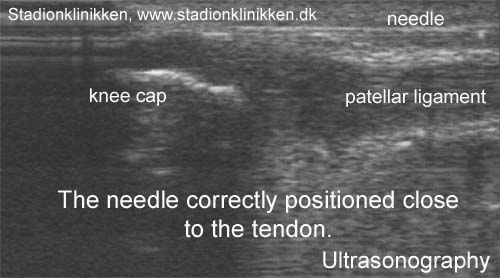
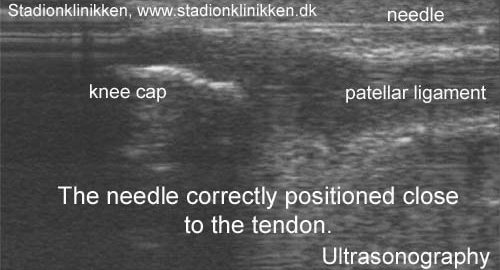



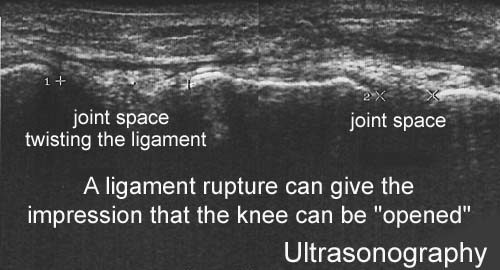
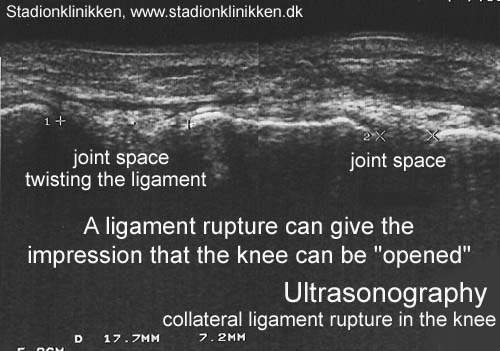
|
|
|
A precise diagnosis can be made in far the majority of cases from the case history and a clinical examination. In many cases it will, however, be advantageous to supplement with: |
|
X-ray, which is primarily used for suspicions of fractures and bone membrane tears (avulsion). The examination entails exposure to x-ray irradiation. |
|
CT-scanning, which is used with certain fractures as a supplement to ordinary x-ray examination. The examination entails marked exposure to x-ray irradiation. |
|
MRI-scanning, which is primarily indicated in cases where further examination of the conditions inside the joints is desired – since ultrasound scanning is easier, considerably cheaper and presumed just as effective in evaluating conditions outside of the joints. The examination entails exposure to magnetic irradiation, which is, as far as anyone knows, harmless. |
|
Diagnostic blockade with local anaesthetic has only modest risks associated with it if performed with the correct injection technique (possibly under guidance of ultrasound), and can contribute with considerable diagnostic information. |
|
Arthroscopy, which is used for diagnostic examination of the conditions in the joint if it is not possible to determine “from outside” what is wrong in the joint despite use of all other modern technology. This method is associated with a number of risks in relation to the other examination methods. |
|
Ultrasound scanning, which is the cheapest, quickest and most suitable examination to enhance the findings from a clinical examination. The examination entails exposure to ultrasound irradiation which is completely harmless. |
|
Ultrasound scanning has developed rapidly over the recent decades. Ultrasound scanning is today an integral part of the clinical examination associated with sports medicine and other rheumatology related conditions, and acts as the physician’s “extended hand”. Ultrasound scanning will generally contribute to clarifying matters where the diagnosis is not certain, or the course of events is not as could be expected. Ultrasound scanning is particularly suitable for revealing the structures outside, and within the joints. The examination allows evaluation of the muscles, tendons and joints when activated (dynamic ultrasound scanning) (Ultrasonic image) as well as ultrasound-guided diagnostic and therapeutic draining of accumulations (blood, joint fluid, etc.). Furthermore, ultrasound-guided injection provides the possibility of placing the needle within a range of precision of 1/10 mm (Ultrasonic image). Injections which have earlier been performed “blind” have only been successfully placed at the desired location in under half of the attempts, and in more than 50% of the cases have erroneously hit other structures. It is for this reason that all injections where error in placement involves certain risks (injection around the large tendons and in the vicinity of large vessels and nerves) should always be performed under guidance of ultrasound. The correct placement of the needle can be performed by direct visualization of the tip of the needle in the most instances, but a small volume of sterile air (less than one drop) acts as an effective contrast medium and can ascertain a 100% correct placement of the needle in all injections, (article), (Ultrasonic image). Examples where ultrasound scanning has enabled precise diagnosis and treatment: |
| Case history 1: Stress fracture (Ultrasonic image) |
| Case history 2: Meniscus lesion, (Ultrasonic image)
Case history 3: Bursitis of the tendon of the knee (Baker’s cyst) (Ultrasonic image) |
| Case history 4: Injection, Jumper’s knee (Ultrasonic image), (Ultrasonic image), (Ultrasonic image).
Case history 5: Myositis ossificans, (Ultrasonic image) |
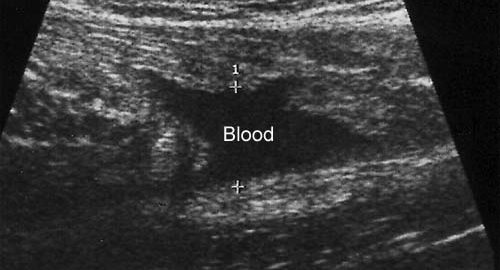
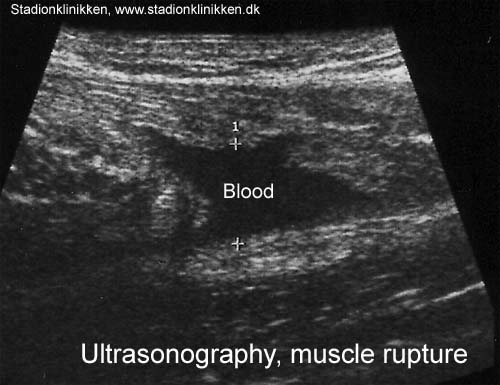
Training ladder for:
MUSCLE RUPTURE IN THE CALF
(RUPTURA MUSCULI)
STEP 4 |
Unlimited: Cycling. Swimming. Running and spurting with jumps.
|
||||||||||||||||||||||||||||||||||||||||||||||||||||||||||
|
Stretching is carried out in the following way: stretch the muscle group for 3-5 seconds. Relax for 3-5 seconds. The muscle group should subsequently be stretched for 20 seconds. The muscle is allowed to be tender, but must not hurt. Relax for 20 seconds, after which the procedure can be repeated. The time consumed for stretching, coordination and strength training can be altered depending on the training opportunities available and individual requirements. |
Training ladder for:
MUSCLE RUPTURE IN THE CALF
(RUPTURA MUSCULI)
STEP 3 |
Unlimited: Cycling. Swimming. Running with increasing speed and skipping.
|
|||||||||||||||||||||||||||||||||||||||||||||||||||||
|
Stretching is carried out in the following way: stretch the muscle group for 3-5 seconds. Relax for 3-5 seconds. The muscle group should subsequently be stretched for 20 seconds. The muscle is allowed to be tender, but must not hurt. Relax for 20 seconds, after which the procedure can be repeated. The time consumed for stretching, coordination and strength training can be altered depending on the training opportunities available and individual requirements. |
Training ladder for:
MUSCLE RUPTURE IN THE CALF
(RUPTURA MUSCULI)
STEP 2 |
Unlimited: Cycling. Swimming. Light jogging.
|
|||||||||||||||||||||||||||||||||||||||||
|
Stretching is carried out in the following way: stretch the muscle group for 3-5 seconds. Relax for 3-5 seconds. The muscle group should subsequently be stretched for 20 seconds. The muscle is allowed to be tender, but must not hurt. Relax for 20 seconds, after which the procedure can be repeated. The time consumed for stretching, coordination and strength training can be altered depending on the training opportunities available and individual requirements. |
Training ladder for:
MUSCLE RUPTURE IN THE CALF
(RUPTURA MUSCULI)
STEP 1 |
| The indications of time after stretching, coordination training and strength training show the division of time for the respective type of training when training for a period of one hour. The time indications are therefore not a definition of the daily training needs, as the daily training is determined on an individual basis.
|
||||||||||||||||||||||||||||||||||||||||||||
|
Stretching is carried out in the following way: stretch the muscle group for 3-5 seconds. Relax for 3-5 seconds. The muscle group should subsequently be stretched for 20 seconds. The muscle is allowed to be tender, but must not hurt. Relax for 20 seconds, after which the procedure can be repeated. The time consumed for stretching, coordination and strength training can be altered depending on the training opportunities available and individual requirements. |
|
Acute tears of the medial head of the gastrocnemius. |